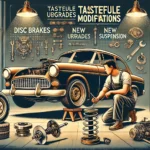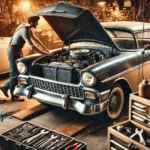Embarking on a cross-country trip in a vintage car is a thrilling adventure, but it requires careful preparation to ensure a smooth and safe journey. Classic cars, with their charm and character, demand a little extra care compared to modern vehicles. Here’s a step-by-step guide to getting your vintage car road-ready for the ultimate long-distance drive.
Step 1: Perform a Full Inspection
A thorough inspection is the foundation of a successful road trip. Before hitting the road, assess your car’s condition to identify potential issues that could cause problems during the journey.
Key Areas to Check:
- Engine and Transmission: Look for oil leaks, strange noises, and ensure smooth performance.
- Brakes: Test the brake pads, rotors, and fluid levels to ensure reliable stopping power.
- Tires: Check for proper inflation, tread wear, and ensure you have a quality spare tire.
- Battery: Test the battery’s charge and clean any corrosion from the terminals.
- Cooling System: Inspect the radiator, coolant levels, and hoses for leaks or cracks.
Hiring a professional mechanic familiar with vintage cars is a wise choice if you’re unsure about doing this yourself.
Step 2: Replace Essential Parts
Even if your car seems to be in great shape, some components should be replaced proactively to avoid issues on the road.
Parts to Consider Replacing:
- Belts and hoses, which can degrade over time.
- Spark plugs and ignition wires for reliable starting.
- Filters (fuel, air, and oil) to maintain engine efficiency.
- Old or worn-out wiper blades for clear visibility.
Replacing these items before your trip will give you peace of mind.
Step 3: Test Drive Your Car
Take your car on a series of test drives before the big trip. Start with shorter drives around your area, gradually increasing the distance.
Benefits of Test Drives:
- Identify any unusual noises or performance issues.
- Test how the car handles under different conditions (e.g., hills, highways).
- Build confidence in your car’s ability to handle a long journey.
A few weeks of regular test drives will help uncover potential problems and give you time to address them.
Step 4: Stock Up on Essentials
Prepare for the unexpected by packing a toolkit and other essentials that will keep you prepared for minor repairs on the road.
What to Pack:
- Tools: Wrenches, screwdrivers, pliers, and a jack.
- Spare Parts: Belts, fuses, bulbs, and a fuel filter.
- Fluids: Engine oil, coolant, transmission fluid, and brake fluid.
- Emergency Supplies: A first-aid kit, flashlight, jumper cables, and reflective triangles.
Having these items on hand can make the difference between a minor delay and a major problem.
Step 5: Plan Your Route
Classic cars aren’t built for speed or endurance like modern vehicles, so choose a route that accommodates your car’s capabilities.
Route Planning Tips:
- Avoid steep mountain passes or extreme weather conditions.
- Include frequent stops for rest and refueling.
- Identify nearby mechanics and gas stations along the way.
Use apps like Google Maps or Waze, but also carry a paper map as a backup in case of signal loss.
Step 6: Adjust for Weather
Vintage cars are more sensitive to extreme weather conditions, so prepare accordingly based on the time of year and region.
Seasonal Considerations:
- Summer: Ensure your cooling system is in top condition and bring sunshades for the interior.
- Winter: Protect your car from snow and ice with antifreeze and tire chains.
- Rainy Seasons: Check the windshield wipers and ensure all lights are functional.
Adapting to the weather will help protect both you and your vehicle.
Step 7: Check Your Insurance and Documents
Ensure that your insurance policy covers long-distance travel and check if it includes roadside assistance. Keep all important documents in the car.
Documents to Bring:
- Vehicle registration and proof of insurance.
- Driver’s license and roadside assistance membership card.
- Maintenance records, in case a mechanic needs them.
Keeping these papers handy will save time in case of an emergency.
Step 8: Plan for Fuel Stops
Classic cars often have lower fuel efficiency, so you’ll need to plan for more frequent refueling.
Fuel Tips:
- Research gas stations along your route.
- Carry a small, approved gas canister for emergencies.
- Avoid running the tank too low to prevent sediment from clogging the fuel system.
Efficient fuel planning will keep your trip on schedule.
Step 9: Pack Comfort and Entertainment Items
Long drives can be tiring, so make sure you’re comfortable and entertained.
What to Bring:
- Cushions and seat covers for added comfort.
- Snacks, water, and a cooler for refreshments.
- A playlist of your favorite road trip songs.
Comfortable drivers make better decisions on the road.
Step 10: Embrace the Journey
Finally, remember that driving a vintage car is about the experience. Take your time, enjoy the scenery, and appreciate the unique joy of classic motoring.
Bonus Tips:
- Stop frequently for photos—your car deserves to be in the spotlight!
- Connect with locals or car clubs along the way.
- Document your trip in a travel journal or through social media.
With proper preparation, your cross-country trip in a vintage car can be a safe and unforgettable adventure. Every mile is a step back in time, blending nostalgia with the thrill of exploration.








